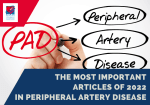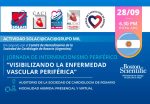On the one hand, chronic peripheral vascular disease is on the rise. On the other, over the past 20 years, percutaneous coronary intervention (PCI) has gained considerable ground thanks to various new devices, replacing surgery as an alternative in most scenarios. Both strategies have shown similar results, but PCI has fewer complications and shorter hospital stays.<a href="https://solaci.org/en/2024/04/18/peripheral-vascular-disease-our-reality-in-latin-america-with-the-latam-solaci-peripheral-registry/" title="Read more" >...</a>
Cilostazol in Diabetic Patients with Endovascular Peripheral Revascularization: One Step Beyond Symptom Improvement
In patients with peripheral vascular disease (PVD), the presence of diabetes has been significantly associated with increased failure of critical lower limb ischemia (CLI) treatment, and higher incidence of amputation. This relationship has been attributed mainly to comorbidities and patient characteristics, concomitant peripheral neuropathy and marked microvascular alteration. Also, a high proportion of these patients<a href="https://solaci.org/en/2023/11/24/cilostazol-in-diabetic-patients-with-endovascular-peripheral-revascularization-one-step-beyond-symptom-improvement/" title="Read more" >...</a>
SOLACI-SBHCI 2023 | Insights from the LATAM Peripheral Registry – Dr. Maximiliano Rossi
Read the most outstanding articles from SOLACI-SBHCI 2023 Congress. In this case, check the presentation by Dr. Maximiliano Rossi, entitled “Insights from the LATAM Peripheral Registry”
TAVR: Vascular Access in Patients with Peripheral Artery Disease, 1-Year Outcomes
At present, the transfemoral access (TFA) is the preferred approach when it comes to transcatheter aortic valve replacement (TAVR). However, 5 to10% of PAD patients present tortuous iliac anatomy and calcification, aortic aneurysms or prior peripheral intervention, which makes it impossible. There are several alternatives to approach these patients: 1) TFA associated to peripheral PCI<a href="https://solaci.org/en/2023/03/17/tavr-vascular-access-in-patients-with-peripheral-artery-disease-1-year-outcomes/" title="Read more" >...</a>
Relationship Between Medical Treatment and Long-Term Clinical Results after Peripheral Vascular Intervention
Peripheral arterial disease (PAD) is one of the consequences of atherosclerosis, and it can cause pain in the limbs or tissue loss. Its treatment includes lifestyle changes such as exercise, statin therapy, antiplatelet therapy, antihypertensive medication (mainly ACE inhibitors or ARBs), and revascularization strategy. One in five patients with PAD will have experienced acute myocardial<a href="https://solaci.org/en/2023/02/24/relationship-between-medical-treatment-and-long-term-clinical-results-after-peripheral-vascular-intervention/" title="Read more" >...</a>
SOLACI Peripheral Registry Hits the 1000-Patient Mark
We are very proud to say that our multicenter, prospective research registry continues to grow by leaps and bounds. We want to congratulate the 36 centers from the 9 participating countries and invite the entire community to join this research initiative that aims to collect data on the reality of lower limb angioplasty in Latin<a href="https://solaci.org/en/2023/02/13/solaci-peripheral-registry-hits-the-1000-patient-mark/" title="Read more" >...</a>
The Most Important Articles of 2022 in Peripheral Vascular Disease
Discover the most important scientific articles of 2022 in peripheral vascular disease in our website. EMINENT Trial | Stent Eluvia vs BMS in Femoropopliteal Territory Endovascular therapy in femoropopliteal territory has become the standard, mainly with self-expanding stents, aimed at preventing early vascular recoil and late constrictive remodeling. Thromboendarterectomy vs. Endovascular Therapy in Common Femoropopliteal<a href="https://solaci.org/en/2023/01/19/the-most-important-articles-of-2022-in-peripheral-vascular-disease/" title="Read more" >...</a>
IVUS Use in Peripheral Vascular Disease: Should this Tool Be Used More Frequently in Peripheral Interventions?
Use of intravascular ultrasound (IVUS) has increased rapidly, and several randomized and observational studies have shown improved results in patients who underwent coronary angioplasty using this tool. However, evidence on IVUS on peripheral interventions is more limited. Observational studies have found similar benefits when IVUS was part of the revascularization strategy. In a meta-analysis of<a href="https://solaci.org/en/2022/11/30/ivus-use-in-peripheral-vascular-disease-should-this-tool-be-used-more-frequently-in-peripheral-interventions/" title="Read more" >...</a>
Making Peripheral Vascular Disease visible. Watch again our event
You can now relive the event that we held together with the Cardiology Society of Rosario, the Argentine College of Interventional Cardioangiologists and the MIL Group, on Visibility of Peripheral Vascular Disease. The event was held in mixed mode (face-to-face and virtual), and featured an outstanding scientific program and the participation of important specialists from<a href="https://solaci.org/en/2022/10/12/making-peripheral-vascular-disease-visible-watch-again-our-event/" title="Read more" >...</a>
Sept 28 – SOLACI@CACI@Grupo MIL Activity | Session on Peripheral Interventions: Making Peripheral Vascular Disease Visible
The Latin American Society of Interventional Cardiology (SOLAC) in conjunction with the Argentine College of Interventional Cardioangiologists (CACI) and the Group of Latin American Interventional Women (MIL) will hold a special day to make peripheral vascular disease more visible. The event will last 2 hours and a half and will be held in a hybrid<a href="https://solaci.org/en/2022/09/12/sept-28-solacicacigrupo-mil-activity-session-on-peripheral-interventions-making-peripheral-vascular-disease-visible/" title="Read more" >...</a>









